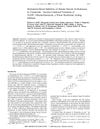Search
forLearn
5 / 5 resultslearn Stem Cell Factor
learn Epidermal Growth Factor
learn sh-Polypeptide-7
learn Beta Polypeptide
Research
5 / 1000+ resultsresearch Human Peptidylarginine Deiminase Type III: Molecular Cloning and Nucleotide Sequence of the cDNA, Properties of the Recombinant Enzyme, and Immunohistochemical Localization in Human Skin
PAD3 plays a key role in hair and skin protein structure and may be linked to skin diseases.

research Successfully Nonsurgical Epidermoid Cyst Management with Recombinant Hydrolytic Enzymes: A Case Report
Enzyme injections can effectively treat epidermoid cysts without surgery.

research PNU 157706, A Novel Dual Type I and II 5α-Reductase Inhibitor
PNU 157706 is a more effective treatment than finasteride for conditions caused by DHT, like enlarged prostate and hair loss.

research Xenobiotic-Metabolizing Enzymes in the Skin of Rat, Mouse, Pig, Guinea Pig, Man, and in Human Skin Models
Different species and human skin models vary in their skin enzyme activities, with pig skin and some models closely matching human skin, useful for safety assessments and understanding the skin's protective roles.

research Mechanism-Based Inhibition of Human Steroid 5α-Reductase by Finasteride: Enzyme-Catalyzed Formation of NADP-Dihydrofinasteride, a Potent Bisubstrate Analog Inhibitor
Finasteride effectively blocks enzyme causing male pattern baldness.
Community Join
5 / 9 results
community FCE 28260: A Forgotten 5α-Reductase Inhibitor
FCE 28260 (PNU 156765), an under-explored 5α-reductase inhibitor, showcases promising results in research by Giudici et al., outperforming well-known treatments like Finasteride in reducing the conversion of testosterone to DHT. Its superior efficacy, demonstrated through lower IC50 values in both natural and human recombinant enzyme studies, suggests it could offer more effective management of DHT-related conditions. Additionally, its lower molecular weight hints at better potential for topical application, potentially offering advantages in treating conditions such as androgenic alopecia. Despite its potential, it has not advanced in development, possibly due to financial limitations, leaving its therapeutic prospects and side effect profile largely unexplored.
community The theory that explains everything. Please help me make this big!
The post and conversation are about the role of the enzyme 3alpha-hydroxysteroid reductase in hair loss and the potential of compounds like procyanidin B2 and sulforaphane to boost its activity for hair regrowth. Further research is needed to develop effective treatments based on this theory.
community UPDATE: The theory that explains everything. Please help me make this big!
Hair loss theory involves 3alpha-hydroxysteroid reductase (3AHD) converting DHT to androstenol. Discussion explores potential treatments and encourages more research.
community Serum based on plant extracts boosts hair growth in weeks.
A serum containing Centella asiatica extracellular vesicles, IGF-1, FGF-7, and caffeine significantly improved hair thickness, density, length, and reduced hair loss after 56 days. The conversation also discusses how treatments like finasteride, minoxidil, and ketoconazole address different aspects of hair loss by reducing DHT, improving blood flow, and lowering inflammation.
community Tropoelastin injections + verteporfin?
The use of tropoelastin injections and verteporfin for hair transplant recipients to help regrow donor area hairs, as well as research done on tropoelastin injections restoring elastin in scarred heart tissue and skin. There are discussions about why it is taking so long to get cosmetic mass produced tropoelastin injectables on the market.